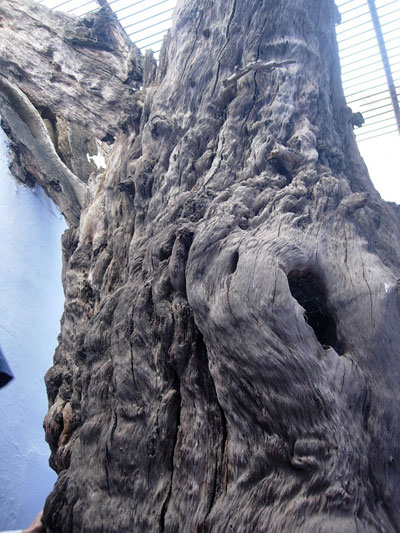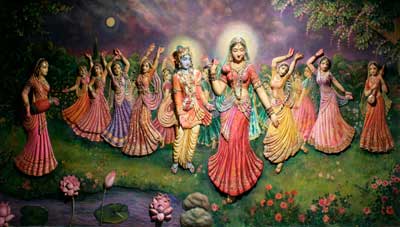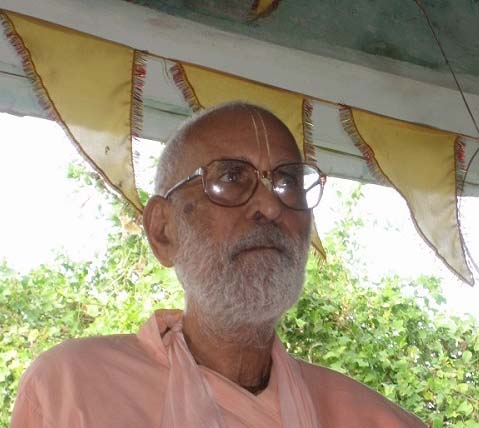Sri Srimad Bhaktivedanta Narayana Gosvami Maharaja
October 20, early 1990s, year unknown
[This lecture is on the topic of Krsna's rasa-lila.]
Today, October 20th (year unknown), the Vraja Mandala Parikrama party visited many holy places of Krsna's pastimes. Among them, two are especially related to rasa-lila. One of these is Imlitala, where, after Krsna left Sri Radha alone on the night of rasa-lila, He lamented in separation from Her and came to the place known as Imlitala. Here, He was so much absorbed in Her that He lost His bluish complexion and became covered by Her golden complexion.
The second place visited is known as Jhadu-mandala. Here, the tree under which the gopis sang their Gopi-gita, their song of separation from Sri Krsna after He left the rasa dance, is still standing in its full glory. [Thus, we feel that today, the 3rd day of Kartika, is an auspicious day to send you this hari-katha lecture, given by Srila Naryana Gosvami Maharaja in Vrndavana, in the early 1990s :]
One year after Krsna made His promise to the gopis, on the full-moon night in autumn He looked at the moon and began to play His flute. He considered, "Our forefather, the moon, has a beloved other than his wife, Rohini. His beloved is Purva-disa, the eastern horizon."
The most erudite Srila Vyasadeva, who knew how to apply all literary metaphors and ornaments (alankara), marvelously described this scene as follows:
Krsna was thinking, "The hands of our forefather, the moon, are smeared with kumkum. Those hands, his rays, are decorating the face of his beloved Purva-disa without any difficulty, and she is shyly accepting that reddish ornamentation. Why should I not do the same?"
In other words, the reddish rays of the moon radiated through-out the forest, bathing the trees and the rivers and everything else in it in a red light.
In that ambrosial atmosphere, thoughts of the gopis came to Krsna's mind, and He remembered His promise to fulfill their innermost desires. He pondered, "By diffusing the reddish hue of his gentle rays and by glowing with the effulgence of newly applied vermilion, Candra (the moon) has reminded Me of My promise and has placed within My heart the inspiration to fulfill it. This is the perfect moment for Me to do so."
Then, on that full moon night of the autumn season, He played a beautiful melody on His flute and the gopis came running to Him. But when they arrived, He told them to return to Vraja. "A lady should serve her husband," He said, "regardless of his qualities. Her husband may be poor or plagued with diseases, but she should serve him under all circumstances."
At first the gopis did not say anything in reply, but within their minds and hearts they questioned, "Does He really mean it or is He joking with us?" They observed Him closely as He tried to cleverly hide His real intention. It seemed that He was honestly expressing Himself in a straightforward manner, but in fact, He was not.
Finally, the gopis said, "You are our guru and, as such, You are giving us so many instructions. We know that even in the presence of God, a person should serve his gurudeva first, so let us first serve You, our gurudeva, before we return to serve our husbands."
In Bhagavad-gita, Krsna says:
ye yatha mam prapadyante
tams tathaiva bhajamy aham
mama vartmanuvartante
manusyah partha sarvasah
Bhagavad-gita (4.11)
"As all surrender unto Me, I reward them accordingly. Everyone follows My path in all respects, O son of Prtha."
 The gopis sang their Gopi-gita under this ancient treeSri Krsna was instructing the gopis and also telling them, "I am God, so you should obey Me".
The gopis sang their Gopi-gita under this ancient treeSri Krsna was instructing the gopis and also telling them, "I am God, so you should obey Me".
The gopis replied, "We agree that if You are God we should certainly obey You, but our first duty is to serve our gurudeva. When we have executed that order, we will obey Your instructions to serve our husbands.
"Our second consideration is this. We know that God is our father, God is our real husband, and God is everything; so if You are God, then You are both our husband and our guru. In every way, if You do not accept our service You will be guilty of acting against the principles of religion. You are giving us instructions on religious principles, but You should practice this Yourself."
At last, rasa began. Krsna danced with Srimati Radhika in the center of the circle of gopis, and at the same time He danced with each of the gopis comprising the circle. It is not that He expanded into as many manifestations of Himself as there were gopis, because in Vrndavana, all His pastimes are free from the mood of opulence (aisvarya). Rather, He danced so quickly, like a firebrand orbiting in a circle, that it simply looked as if He were constantly and simultaneously dancing with each and every gopi. Had He expanded into many manifestations of Himself, this pastime would have been aisvarya-lila. Instead, He was engaged in human-like pastimes (nara-lila).
Many commentators have written that Krsna manifested His kaya-vyuha, direct expansions of His personal form, when He was dancing in the rasa-lila, but Srila Visvanatha Cakravarti Thakura says that this is not so. He refutes the idea that the expansions of Krsna's form performed this pastime, asserting that if His expansions had done so, it would be a lila of VaikunTha. He explains that in fact, only Krsna's original form (svayam-rupa) performed this transcen-dental pastime. We thus conclude that Krsna moved like a lightning flash from gopi to gopi, dancing with each one in turn.
Srimati Radhika saw that Krsna was dancing with Her. Then, as She cast Her gaze over all the other gopis, She saw that Krsna was dancing with each of them as well. Each gopi thought, "Krsna is dancing only with me." Srimati Radhika alone could see Him with each and every gopi.
Krsna's performance of rasa-lila in this way – manifesting no aisvarya by bringing forth expansions of His form, but in fact whirling from gopi to gopi – was certainly miraculous. Moreover, He performed many varieties of activities with the gopis as they danced together. He asked one gopi if she were fatigued, He gently wiped drops of perspiration from the face of another, and He fastened ankle-bells on the ankles of another. With each and every gopi He engaged in various interactions, and thus each gopi became maddened in their love for Him.
The gopis' madness here, in which they were intoxicated by their own good fortune, is called saubhagya-mada. In this regard Srimad-Bhagavatam states:
tasam tat-saubhaga-madam
viksya manam ca kesavah
prasamaya prasadaya
tatraivantaradhiyata
Srimad-Bhagavatam (10.29.48)
"Lord Kesava, seeing the gopis too proud of their good fortune, wanted to relieve them of this pride and show them further mercy. Thus He immediately disappeared."
It is stated here that the gopis as an entire group exhibited both saubhagya-mada and mana. However, if we take a closer look at the meaning, it becomes apparent that mana was only exhibited by Srimati Radhika. Only She could see Krsna dancing with the other gopis. The other gopis did not see this, and thus they were intoxicated by their good fortune in which they perceived Krsna dancing with them alone.
When a hero (nayaka) is controlled by a heroine (nayika), the heroine thinks herself to be the most fortunate beloved. This for-tune is called saubhaga and, as it evolves, it brings her to saubhagya-mada. Generally mada means intoxication through drinking, but saubhagya-mada means intoxication from the pride of thinking, "In all of Vraja, there is no one equal to me in good fortune."
In this state, the gopis became so proud that if they had been aware of Krsna's dancing with other gopis, they would have developed mana. Then, in that angry and sulky mood, they would have been completely unable to continue participating in rasa-lila with the other gopis. Instead, each gopi was convinced that she had Krsna fully under her control, that He was captivated and controlled by her and obedient to her every command.
Krsna understood this and considered, "I have decided to sport with all the gopis and fulfill all their most cherished desires, but there is no hope of that happening unless they change their mood. Somehow their pride must be removed."
 He then saw that Radhika was no longer there in rasa-lila. In Her mana, She had abruptly left that place and was going elsewhere. Then, suddenly, Krsna also disappeared, and all of the gopis began their search for Him.
He then saw that Radhika was no longer there in rasa-lila. In Her mana, She had abruptly left that place and was going elsewhere. Then, suddenly, Krsna also disappeared, and all of the gopis began their search for Him.
Some commentators say that Krsna became invisible, but Srila Visvanatha Cakravarti Thakura explains that He did not. Rather, He went to a nearby kunja and hid there.
There were four kinds of gopis present in the rasa-lila on the bank of Yamuna: svapaksa, those in Radhika's own (sva) group (paksa); vipaksa, those in the rival group of Candravali; suhrd-paksa, those who are friendly toward Radhika; and tatastha-paksa, those who are neutral to Her party. Actually, svapaksa can refer to either Radhika's group or Candravali's group. For those in Radhika's group, Candravali is vipaksa, and for those in Candravali's group, Radhika is vipaksa. Syamala is friendly toward Radhika, which means she is neutral to Candravali. Bhadra, on the other hand, is friendly toward Candravali and neutral to Radha.
Within these four main groups of gopis, there were hundreds upon hundreds of sub-categories, and all were searching for Krsna. The gopis in Radha's group could not see their yuthesvari (group-leader), Sri Radha, so they were searching for Her as well as for Krsna. All the other gopis were searching only for Krsna.
Srimad-Bhagavatam's Canto Ten, Chapter Thirty describes the gopis' search for Krsna, and how they all became tadatmika with Him. This means they became so absorbed in remembering His characteristics, such as the way He walked and how sweetly He talked, that they began to think that they themselves were Him.
The gopis became like mad persons, asking the trees, creepers, rivers, deer, and peacocks if they had seen Krsna. They asked the Tulasi plant, but when Tulasi did not respond, the gopis thought, "Oh, Krsna has warned her not to tell us where He is, and because she is His beloved, she refuses to utter a word." They asked the trees, but when they did not reply, the gopis thought, "These trees are male and therefore they are Krsna's friends. He has no doubt told them not to tell us where He is. This is why they are remaining silent." When the gopis saw the creepers laden with flowers, they thought, "Krsna has touched these beautiful creepers with His fingers, and now they are so happy that they have no awareness of anything external. They cannot speak because they have taken leave of their external senses altogether."
At first the gopis concluded that Krsna was not to be found any-where and that He would not return to them. They were somewhat consoled, however, when they finally noted His footprints. They followed His footprints for some distance until, to their surprise, they saw another set of footprints.
The vipaksa gopis (the rivals of Srimati Radhika) were trying to guess whose footprints these were. They could see that the second set of footprints belonged to some gopi. They guessed that this gopi must have worshiped God, and as a result She had become so dear to Krsna that He took Her with Him and left the rasa dance. They did not think that Her good fortune was the result of Her worshiping Krsna, but worshiping God. Thus they spoke the following words:
anayaradhito nunam
bhagavan harir isvarah
yan no vihaya govindah
prito yam anayad rahah
Srimad-Bhagavatam (10.30.28)
"Certainly this particular gopi has perfectly worshiped the all-powerful Personality of Godhead, since He was so pleased with Her that Govinda abandoned the rest of us and brought Her to a secluded place."
When Srimati Radhika's svapaksa gopis saw those footprints, they immediately recognized them, as they were accustomed to serving Her lotus feet and knew the symbols on them. Therefore, seeing Her footprints next to Krsna's overwhelmed those gopis with joy.
After tracing the footprints a short distance, the gopis now saw only one set of footprints instead of two. They could not see the footprints of the gopi; they could only see Krsna's footprints, which were now an inch deeper in the earth. They assumed that when Krsna and this beloved gopi reached this spot, She had become tired and told Him, "I cannot walk any further." He therefore took Her up in His arms and carried Her.
Further on, the gopis noticed that in one spot, the upper parts of the creepers were laden with blossoms, but that the lower part had far less, some having been scattered on the ground. From this they guessed that Krsna had seated His beloved in that place and decorated Her with flowers.
As the gopis proceeded further, they beheld that very gopi. Alone, and completely unconscious of Her surroundings, She was rolling on the ground, bitterly weeping:The Sanskrit word for 'decoration' is srngara, and that place where Krsna decorated Srimati Radhika in Vrndavana became famous as Srngara-vata.
ha natha ramana prestha
kvasi kvasi maha-bhuja
dasyas te krpanaya me
sakhe darsaya sannidhim
Srimad-Bhagavatam (10.30.39)
"She cried out: O master! My lover! O dear most, where are You? Where are You? Please, O mighty-armed one, O friend, show Yourself to Me, Your poor servant!"
Sri Caitanya Mahaprabhu and Srila Madhavendra Puri used to repeat this verse, and as they did so, their hearts full of bhava (transcendental mood), tears would pour forth from their eyes.
All of the gopis – svapaksa, suhrd, tatastha, and vipaksa – then approached Srimati Radhika and expressed their sympathy, for it is the nature of women to feel compassion for someone weeping. Although Candravali generally feels envy towards Srimati Radhika, when she saw Radhika weeping and rolling on the ground, suffering more than all the other gopis, even her heart softened.
Another reason Candravali felt sympathy for Radhika is that she is Radhika's sister. Actually, they are cousin-sisters, as their fathers, Candrabhanu and Vrsabhanu, are brothers. Srimati Radhika and Candravali love each other, but there is also some rivalry between them. Candravali is a little older than Radhika, but Radhika is more beautiful and qualified in every way.
Upon seeing Krsna dancing with all the other gopis, and at the same time dancing with Her, Radhika had left the rasa dance in a sulky mood (mana). Yet, when She was alone with Krsna in the forest, She wanted those gopis to be with Krsna and Her. This is an example of vyabhicari-bhava, in which mana and other bhavas rise up and subside, and sometimes combine with each other. This is likened to one wave rising up and overtaking another wave, thus causing the water from both waves to merge. After that, the same process is repeated and new waves appear. This is similar to the way in which Radhika's mana disappeared due to Her being immersed in Krsna's loving dealings with Her. She then thought that all Her svapaksa gopis should come together, but since all the gopis were searching together, they all came. When the gopis found Srimati Radhika in this condition, they sprinkled some water on Her lotus face. When She came to external consciousness, they asked Her, "What has upset You? Why are You so overwhelmed and weeping?"
"As I was wandering throughout the forest with Krsna," Srimati Radhika replied, "I told Him that I was no longer able to walk."
Why had She said that to Sri Krsna? It was not due to saubhagya-mada, the pride in Her incomparable good fortune. Rather, Her deep contemplation was as follows: "My sakhis have left everything for Me. They have no purpose other than to serve Me, yet I am here, enjoying Krsna's company alone. This is not at all fair. If I arrange for all of them to come and join Us, we can all enjoy rasa together. I should not be with Krsna alone." In the meantime, the other gopis had been gradually coming nearer and nearer.
Krsna told Her, "Quickly! Come with Me."
"But I cannot see You!" Srimati Radhika cried.
Radhika's condition at this time is called prema-vaicittya. Krsna was actually sitting with Her and worshiping Her, yet She felt an intense mood of separation from Him. She was unable to perceive that He was sitting right beside Her.
As the gopis came closer, Krsna thought, "If they see Us alone together, they will become envious of Radhika and everything will be spoiled; there will be no rasa-lila. I cannot let this happen."
At that very moment, Krsna disappeared from that place and hid Himself in a kunja somewhere in the darkness. Radhika fell to the ground in distress and it was then that the gopis found Her. "What happened to You?" they now asked.
Somewhat hiding Her real bhava of selflessly wanting them to also dance with Krsna in rasa-lila, She simply told them. "I became maddened with the pride of My good fortune, just as you did. Now He has left Me as well."
Then, as one collective party, the gopis began to search for Krsna. Finally they decided that the only way He could be found would be through sankirtana, chanting His glories in a mood of deep separation from Him. Thus, they returned to the bank of Yamuna and began to sing jayati te 'dhikam, the first verse of their Gopi-gita.









